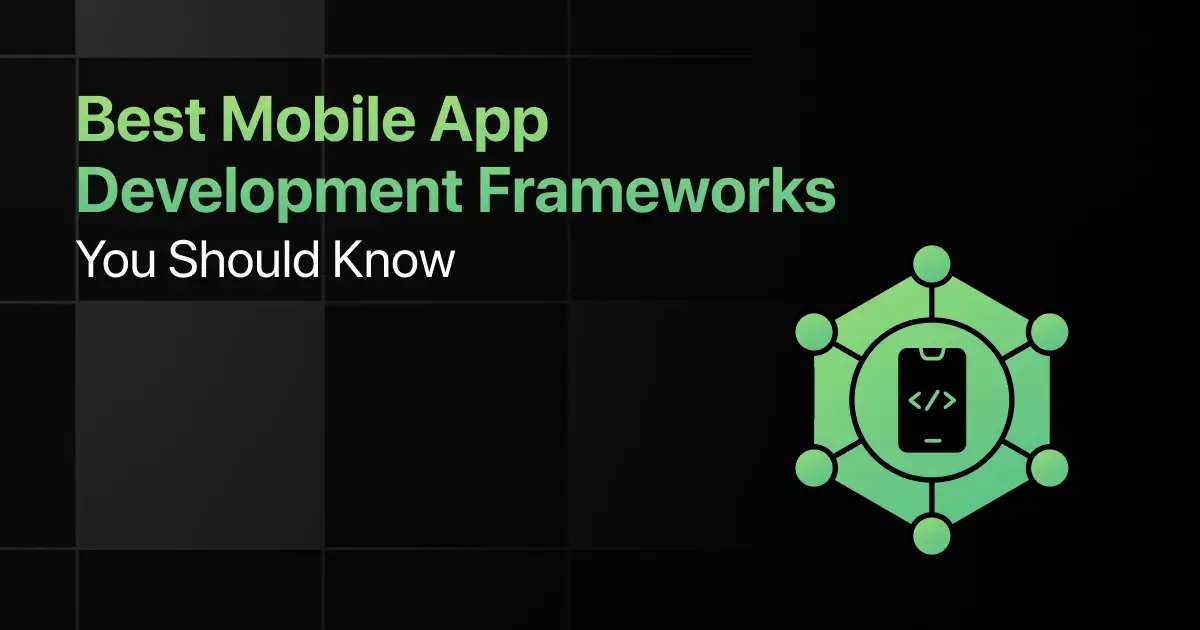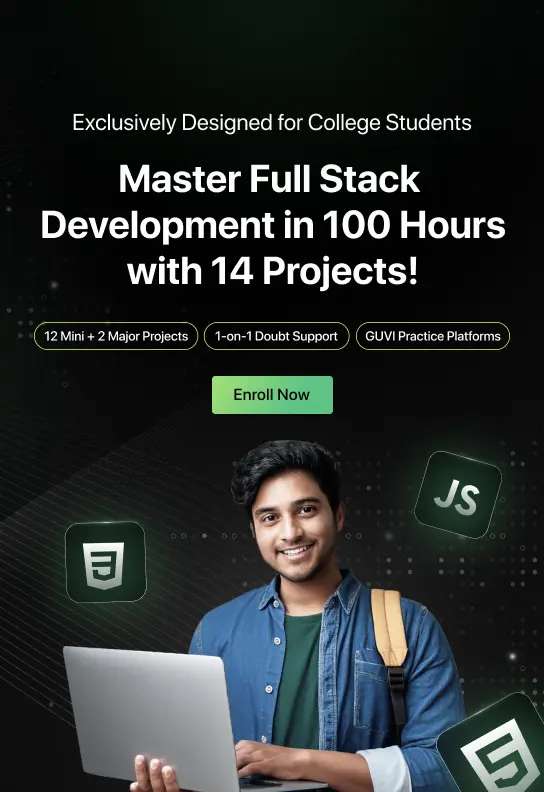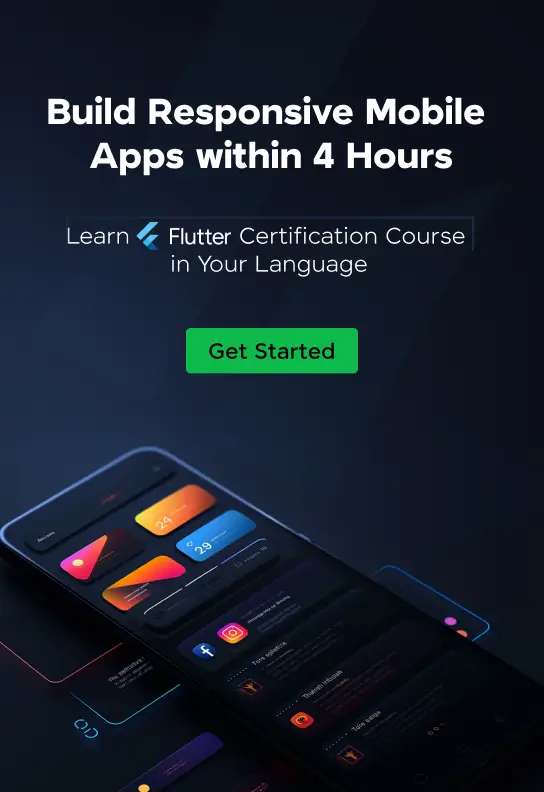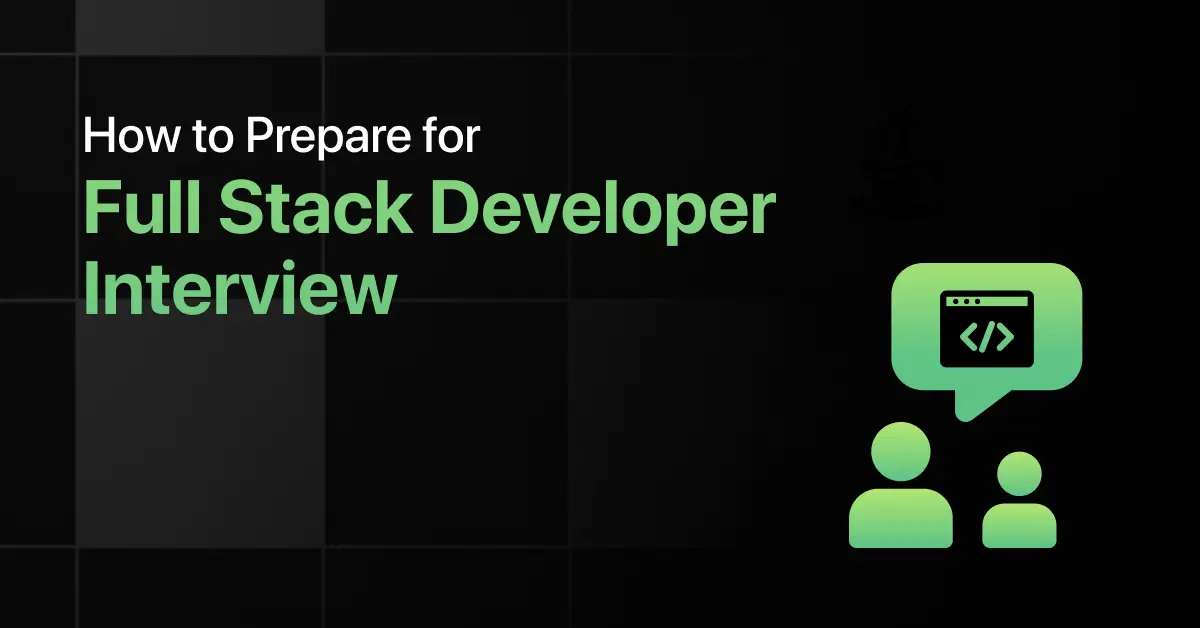Best Mobile App Development Frameworks You Should Know

Mobile app development frameworks are essential tools for developers. They provide a structured foundation to build applications.
This blog will explore a mobile app development frameworks list and highlight the unique features of the best mobile app development frameworks and libraries.
If you’re looking for mobile app development frameworks for beginners or aiming to conduct a detailed mobile app development frameworks comparison, this guide has you covered.
Top Mobile App Development Frameworks – Overview
Here’s an overview of the 10 best frameworks for mobile app development:
| S.No. | Framework Name | Key Features | Ease of Integration | Download Link |
|---|---|---|---|---|
| 1 | React Native | Cross-Platform, Reusable Components | Easy | Download |
| 2 | Flutter | Hot Reload, Pre-Designed Widgets | Easy | Download |
| 3 | Xamarin | Native API Access, Single Codebase | Medium | Download |
| 4 | SwiftUI | Declarative Syntax, Cross-Platform | Easy | Download |
| 5 | Kotlin Multiplatform | Shared Business Logic, Kotlin Syntax | Medium | Download |
| 6 | Ionic | Cross-Platform Compatibility, Pre-Designed UI Components | Easy | Download |
| 7 | Adobe PhoneGap | Cross-Platform Compatibility, Access to Native APIs | Easy | Download |
| 8 | NativeScript | Native API Access, Cross-Platform | Medium | Download |
| 9 | Corona SDK | 2D Graphics Support, Cross-Platform | Easy | Download |
| 10 | Mobile Angular UI | AngularJS Components, Bootstrap Integration | Medium | Download |
Most Popular App Development Frameworks You Should Know
Below are the top 10 mobile app development frameworks you should know:
1. React Native
React Native is a popular framework developed by Facebook that allows developers to build mobile applications using JavaScript and React.
It enables the development of natively rendered mobile apps for both iOS and Android platforms.
Popularity:
- Widely used by top tech companies.
- Preferred for cross-platform development.
- Common in startup environments.
Key Features:
- Cross-platform compatibility
- Reusable components
- Fast refresh
Learning Curve: Easy
Performance: High performance with native rendering
Compatibility:
- Works with iOS and Android.
- Integrates with existing native code.
Ease of Integration: Easy
Use Cases and Industry Adoption:
- Social media apps
- E-commerce platforms
- News and media apps
Job Market Demand:
- High demand in startups and tech companies.
- Widely used in mobile development projects.
- Preferred by cross-platform developers.
2. Flutter
Flutter is an open-source UI toolkit created by Google for building natively compiled applications for mobile, web, and desktop from a single codebase.
It uses the Dart programming language.
Popularity:
- Rapidly growing in popularity.
- Preferred for building visually attractive apps.
- Used by many startups and large enterprises.
Key Features:
- Hot reload
- Rich set of pre-designed widgets
- Single codebase for multiple platforms
Learning Curve: Medium
Performance: High performance with fast rendering
Compatibility:
- Works with iOS and Android.
- Integrates with various backend services.
Ease of Integration: Easy
Use Cases and Industry Adoption:
- Mobile apps
- Web applications
- Desktop applications
Job Market Demand:
- Increasing demand in the tech industry.
- Used by startups and large companies.
- Preferred for cross-platform development.
3. Xamarin
Xamarin is a Microsoft-owned framework that allows developers to build native Android, iOS, and Windows apps using C# and .NET.
It provides a single codebase for all platforms.
Popularity:
- Widely used in enterprise applications.
- Preferred by C# developers.
- Common in cross-platform projects.
Key Features:
- Native API access
- Single shared codebase
- Strong community support
Learning Curve: Medium
Performance: Good performance with native capabilities
Compatibility:
- Works with iOS, Android, and Windows.
- Integrates with Visual Studio.
Ease of Integration: Medium
Use Cases and Industry Adoption:
- Enterprise applications
- Cross-platform development
- Internal business apps
Job Market Demand:
- High demand in enterprise environments.
- Used by large corporations.
- Preferred by C# and .NET developers.
4. SwiftUI
SwiftUI is a modern UI toolkit by Apple for building user interfaces across all Apple platforms using Swift.
It simplifies the development process with declarative syntax.
Popularity:
- Popular among iOS developers.
- Widely adopted for new iOS projects.
- Preferred for building modern Apple apps.
Key Features:
- Declarative syntax
- Cross-platform (iOS, macOS, watchOS, tvOS)
- Real-time previews
Learning Curve: Easy
Performance: High performance with native Swift
Compatibility:
- Works with all Apple platforms.
- Integrates with existing Swift code.
Ease of Integration: Easy
Use Cases and Industry Adoption:
- iOS applications
- macOS applications
- watchOS and tvOS applications
Job Market Demand:
- High demand in the Apple ecosystem.
- Used by tech companies and startups.
- Preferred for developing modern Apple apps.
5. Kotlin Multiplatform
Kotlin Multiplatform is an SDK by JetBrains. It allows developers to write code once and run it on multiple platforms, including iOS, Android, and web.
Popularity:
- Gaining popularity among Kotlin developers.
- Preferred for cross-platform projects.
- Used by many tech companies.
Key Features:
- Shared business logic
- Kotlin syntax
- Interoperability with native code
Learning Curve: Medium
Performance: High performance with native capabilities
Compatibility:
- Works with iOS, Android, and web.
- Integrates with existing Kotlin projects.
Ease of Integration: Medium
Use Cases and Industry Adoption:
- Cross-platform mobile apps
- Shared business logic across platforms
- Multi-platform projects
Job Market Demand:
- Increasing demand in cross-platform development.
- Used by tech startups and large companies.
- Preferred by Kotlin developers.
6. Ionic
Ionic is an open-source framework for building cross-platform mobile apps using web technologies like HTML, CSS, and JavaScript.
It allows developers to create high-quality mobile apps with a single codebase.
Popularity:
- Widely used for hybrid mobile app development.
- Preferred for web-to-mobile transitions.
- Common in small to medium-sized projects.
Key Features:
- Cross-platform compatibility
- Pre-designed UI components
- Extensive plugin library
Learning Curve: Easy
Performance: Good performance with hybrid capabilities
Compatibility:
- Works with iOS and Android.
- Integrates with Angular, React, and Vue.
Ease of Integration: Easy
Use Cases and Industry Adoption:
- Hybrid mobile apps
- Web-to-mobile applications
- Cross-platform development
Job Market Demand:
- High demand in hybrid app development.
- Used by startups and small businesses.
- Preferred for quick web-to-mobile transitions.
7. Adobe PhoneGap
Adobe PhoneGap is an open-source mobile development framework. It allows developers to build cross-platform mobile applications using HTML, CSS, and JavaScript.
Popularity:
- Widely used for hybrid mobile app development.
- Preferred for web-to-mobile transitions.
- Common in small to medium-sized projects.
Key Features:
- Cross-platform compatibility
- Access to native device APIs
- Extensive plugin library
Learning Curve: Easy
Performance: Moderate performance with hybrid capabilities
Compatibility:
- Works with iOS and Android.
- Integrates with various web technologies.
Ease of Integration: Easy
Use Cases and Industry Adoption:
- Hybrid mobile apps
- Web-to-mobile applications
- Cross-platform development
Job Market Demand:
- Moderate demand in hybrid app development.
- Used by startups and small businesses.
- Preferred for quick web-to-mobile transitions.
8. NativeScript
NativeScript is an open-source framework for building native mobile applications using JavaScript, TypeScript, or Angular.
It allows developers to write and deploy native mobile apps from a single codebase.
Popularity:
- Popular among JavaScript and TypeScript developers.
- Widely used for cross-platform development.
- Preferred for native performance.
Key Features:
- Native API access
- Cross-platform compatibility
- Supports Angular and Vue.js
Learning Curve: Medium
Performance: High performance with native rendering
Compatibility:
- Works with iOS and Android.
- Integrates with Angular and Vue.js.
Ease of Integration: Medium
Use Cases and Industry Adoption:
- Cross-platform mobile apps
- Native performance applications
- JavaScript and TypeScript projects
Job Market Demand:
- Increasing demand in cross-platform development.
- Used by tech startups and companies.
- Preferred by JavaScript and TypeScript developers.
9. Corona SDK
Corona SDK, also known as Solar2D, is a cross-platform framework for building 2D mobile applications and games using Lua.
It focuses on speed and ease of use.
Popularity:
- Popular in game development.
- Widely used for 2D mobile apps.
- Preferred for rapid development.
Key Features:
- 2D graphics and animation support
- Cross-platform compatibility
- Real-time simulation
Learning Curve: Easy
Performance: High performance for 2D graphics
Compatibility:
- Works with iOS and Android.
- Integrates with various game development tools.
Ease of Integration: Easy
Use Cases and Industry Adoption:
- 2D mobile games
- Educational apps
- Rapid development projects
Job Market Demand:
- High demand in game development.
- Used by indie developers and small studios.
- Preferred for rapid 2D app development.
10. Mobile Angular UI
Mobile Angular UI is a framework that combines AngularJS and Bootstrap to create mobile applications.
It provides essential mobile components not found in Bootstrap.
Popularity:
- Popular among AngularJS developers.
- Widely used for hybrid mobile apps.
- Preferred for web-to-mobile transitions.
Key Features:
- AngularJS components
- Bootstrap integration
- Responsive design
Learning Curve: Medium
Performance: Good performance with hybrid capabilities
Compatibility:
- Works with iOS and Android.
- Integrates with AngularJS and Bootstrap.
Ease of Integration: Medium
Use Cases and Industry Adoption:
- Hybrid mobile apps
- Web-to-mobile applications
- AngularJS projects
Job Market Demand:
- Moderate demand in hybrid app development.
- Used by startups and small businesses.
- Preferred by AngularJS developers.
Final Words
For beginners, starting with the recommended mobile app development frameworks in this blog can ease your learning curve.
Mastering the top 10 mobile app development frameworks will equip you with the knowledge and tools needed to build scalable mobile applications.
Explore More App Development Resources
- Best Languages for App Development
- Android Development Websites
- Android YouTube Channels
- Android Project Ideas
- Swift Project Ideas
- Kotlin Project Ideas
- Flutter IDEs and Code Editors
Explore More Frameworks
- Java
- Python
- JavaScript
- HTML
- CSS
- Web Development
- C Programming
- Automation Testing
- PHP
- Machine Learning
- Unit Testing
- Big Data
- Ruby
- Data Science
- DevOps
- Blockchain
- Golang
FAQs
The best mobile app development frameworks to use in 2024 are:
- React Native
- Flutter
- Xamarin
- SwiftUI
- Kotlin Multiplatform
The key features you should look for in a mobile app development framework are cross-platform support, performance, community support, and job market demand.
Flutter and React Native are the easiest mobile app development frameworks to learn for beginners.
Common use cases include cross-platform apps (React Native, Flutter), native iOS apps (SwiftUI), and enterprise applications (Xamarin).
Some lightweight mobile app development frameworks for rapid application development are Flutter, React Native, and SwiftUI.
Top companies use React Native, Flutter, and Xamarin for their mobile app development.
There is a high demand for skills related to React Native, Flutter, and Xamarin in the job market, especially in tech startups and large enterprises.
Related Posts


How to Prepare for .Net Interview
Are you preparing for a .NET interview but not sure which topics to prioritize? Many candidates struggle to balance C# fundamentals, …
Warning: Undefined variable $post_id in /var/www/wordpress/wp-content/themes/placementpreparation/template-parts/popup-zenlite.php on line 1050










